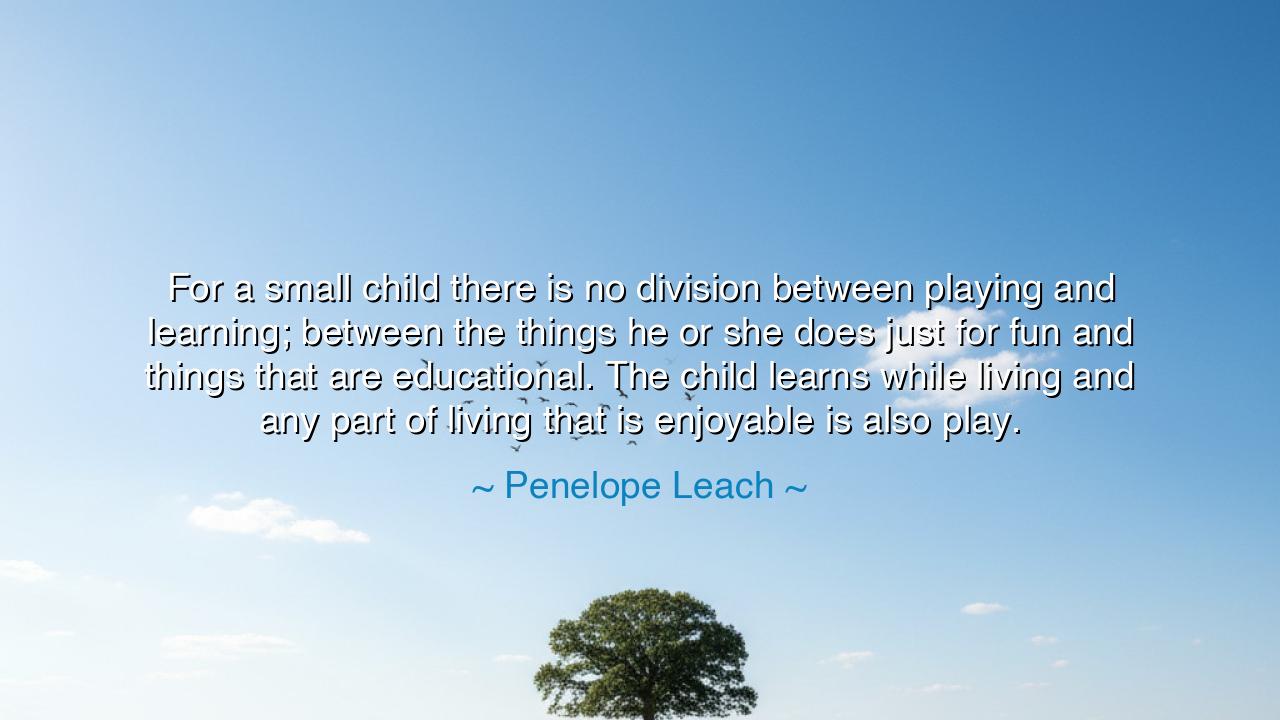
For a small child there is no division between playing and
For a small child there is no division between playing and learning; between the things he or she does just for fun and things that are educational. The child learns while living and any part of living that is enjoyable is also play.






“For a small child there is no division between playing and learning; between the things he or she does just for fun and things that are educational. The child learns while living and any part of living that is enjoyable is also play.” Thus spoke Penelope Leach, the wise scholar of early childhood, whose words unveil the most innocent and profound truth of all — that learning and joy were never meant to be separate. In her observation of children, she glimpsed the divine pattern that adults too often forget: that the act of discovery is born from delight, and that true wisdom begins in wonder. The child does not distinguish between effort and enjoyment, between study and play — for to the pure mind, life itself is learning, and every experience is a teacher.
The ancient philosophers would have nodded in agreement with her. Plato once said that children should be taught through play, for “nothing that is forced stays in the soul.” In this he echoed a universal principle — that learning thrives in freedom. The child at play does not know he is growing wiser; yet as he builds his tower of stones or chases butterflies across the field, he is practicing the arts of balance, curiosity, and perseverance. His laughter is not separate from his education — it is his education, for in it he learns to trust the world, to explore without fear, and to find meaning in joy.
Penelope Leach saw that we, in our seriousness, forget what the child remembers naturally: that living and learning are one. We divide life into hours of labor and hours of rest, into the “useful” and the “useless,” into “work” and “play.” But the child, untouched by such illusions, knows no such barriers. When a child builds a sandcastle, she is also studying gravity and shape. When she pretends to be a hero, she is learning courage. When she sings nonsense songs to the wind, she is mastering language and imagination. The adult calls it play — the child calls it life.
Consider the story of Maria Montessori, who transformed education by observing this very truth. In her classrooms, she allowed children to explore freely, to choose their own tasks, to follow their curiosity. She found that, when allowed to learn through play, children did not grow idle — they grew radiant. They concentrated deeply, they created naturally, and they learned more swiftly than those who were commanded to sit and memorize. Her schools, now spread across the world, are living proof that joy and wisdom are not opposites, but companions.
This truth extends far beyond childhood. For even as adults, when we engage in work that feels like play, we enter that same state of deep living-learning. The painter who loses herself in color, the scientist who delights in experiment, the gardener who tends each seed with quiet love — all are returning to the same ancient harmony that the child knows instinctively. When joy and curiosity guide us, effort becomes effortless, and discipline becomes devotion. The soul grows not through drudgery, but through passion.
Yet this union of play and learning requires humility — the courage to see the world again with the eyes of a child. Too often, we grow cynical; we tell ourselves that play is for the young, and that maturity means seriousness. But in doing so, we shut the gates of wonder. We forget that the greatest inventors, artists, and thinkers — from Einstein to Da Vinci — were those who never stopped playing. Einstein once said, “Play is the highest form of research.” The child’s joy is not a distraction from wisdom — it is its first language.
Therefore, let us remember the wisdom of Penelope Leach: to nurture the child, we must preserve her freedom to play; to nurture ourselves, we must reclaim that same spirit. Let every lesson be touched by delight, every task by curiosity. When teaching a child, do not crush their joy beneath instruction; when learning yourself, do not seek only utility — seek wonder. The true scholar is the one who plays with ideas as a child plays with stones, shaping beauty from curiosity and delight.
So take this lesson to heart, O seeker of understanding: life itself is the great classroom, and the world, if met with joy, will always be your teacher. The child within you still knows how to learn — not through force, but through play. Feed that inner student. Laugh as you learn. Build, explore, imagine. For as Penelope Leach teaches, every act of joyful living is an act of learning, and every moment of learning, when embraced with wonder, is an act of life itself.






AAdministratorAdministrator
Welcome, honored guests. Please leave a comment, we will respond soon